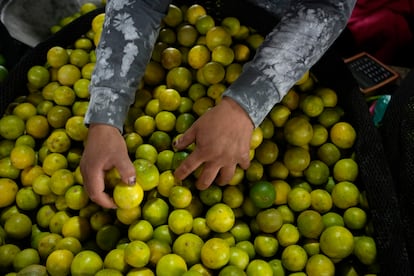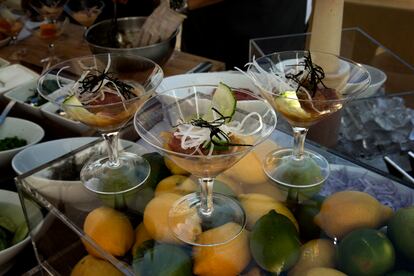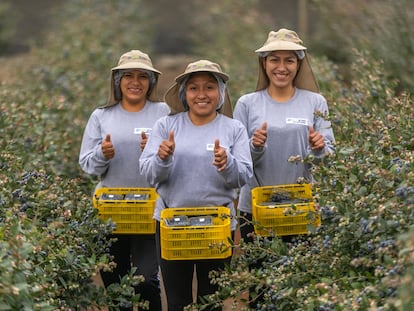The lime crisis: Why ceviche has become a luxury for Peruvians
The price of a kilo of the citrus fruit has gone from less than $1 to around $16 in some areas of Peru. While traders are reinventing themselves, a government minister has already been removed from office over the issue

For several weeks now, people in Peru have not been wrinkling their faces when they suck on limes, but rather because the price of limes has risen to the point of making them unattainable. It’s a sour truth that can be confirmed with a question that is asked every day: how much does a kilo of limes cost in Lima and the provinces? That inquiry has as many searches as the current exchange rate. Perhaps it is the new indicator of how the country is doing.
Is it possible to prepare ceviche without lime? That’s an existential question in a land that is deeply proud of its food and alarmed because its signature dish, labeled as the Nation’s Cultural Heritage since 2004, is under threat. In its purest form, ceviche has five ingredients: raw fish, salt, chili, onion and lime. In its most modern version, ceviche’s magic resides in the instantaneous maceration of all these ingredients in a quick trip from the bowl to the table. Experts say that without the Peruvian lime’s acidity level, it is not possible to make ceviche just right, with a balance of freshness, spiciness and notes of citrus.
According to the National Institute of Statistics and Informatics (INEI), the price of limes increased by 121.7% between June and August. However, the figures soar even higher when one considers that in the first quarter of the year, a kilo of limes cost three soles (8 cents), while in early September it was reported that in Chiclayo, the capital of the coastal region of Lambayeque, the price had skyrocketed to 60 soles ($16.20) per kilo. In Lima, the fruit’s cost has reached 20 soles ($5.40) per kilo in supermarkets and food markets. Although the price has fallen to an average of 9.50 soles ($2.50) in recent days, the outlook remains uncertain.
A clarification is in order: Peruvian limes are not Peruvian. The lime was brought from Southeast Asia during the Spanish conquest to the northern coast of Peru and planted mainly in the Piura region. It was originally called Ceutí lime, a reference to Ceuta, the North African city belonging to Spain that cultivated a variety of this lime; since then, it has been renamed the subtle lime. Indeed, it is customary to say that it has a very subtle flavor. The fruit’s acidity is rather intense and unique, not to say irreplaceable. Not only is it an essential ingredient for ceviche but also for making a pisco sour, Peru’s national cocktail, and chicha morada, a typical drink for export.

Recognized as South America’s best culinary destination in the latest edition of the World Travel Awards, food is a matter of state in Peru. As such, the country’s highest authorities were obligated to be accountable to the people. A couple of weeks ago, the Minister of Economy, Alex Contreras Miranda, suggested that the population substitute sauteed chicken for ceviche and that ceviche restaurants offer other dishes like rice with seafood or fried squid. In the face of the criticism that followed, Contreras had to apologize: “I’m taking this opportunity to acknowledge that I was not sufficiently clear and assertive. I did not intend to interfere in families’ economic decisions. I recognize that a mistake has been made.” In fact, the most recent Datum survey showed that his disapproval rating has increased from 59% to 64% since his comments.
In spite of everything, the president of Peru, Dina Boluarte supported Contreras. Such was not the case for Nelly Paredes del Castillo, who was the Minister of Agrarian Development and Irrigation until last week. Paredes minimized the crisis, implying that lime is minimally important in the family market basket. “It only makes up 2% of everything we Peruvians consume, so let’s use substitutes. Let’s add a little more salt, vinegar and cider to salads. The market also has Persian lime. It is sweeter, but I think it is time for all Peruvians to do our part,” she said. The consequences were sour: on September 6, Jennifer Contreras Alvarez was appointed to take her place.
According to the Association of Peruvian Agrarian Producers (Asociación de Productores Agrarios del Perú), the increase in the price of limes stems from natural hazards: the coastal El Niño phenomenon and cyclone Yaku. The soil was soaked by the rain, severely affecting the lime trees. They were either infested by fungi and mites or bore very small fruit. Piura was the region most affected by these problems; it also accounts for 60% of the country’s citrus production (16,904 hectares under cultivation). In addition, Peru is experiencing a fertilizer crisis that dates back to Pedro Castillo’s government. “Many growers reduced fertilization, leaving plantations in a weak state amid a critical situation like this,” says Rubén Carrasco, president of the Lima Chamber of Commerce’s Crop Protection Association (Protec).
Although the lime harvest usually decreases in August, September and October, the matter is complicated by the fact that the harvest of the so-called green gold occurs four years after the planting period, so increasing the cultivation areas will not reverse the situation in the short term; if increased planting is implemented, it will be a more long-term measure. Are Peruvians willing to accept that their ceviche will have a different flavor and perhaps a different fragrance and texture as well? That is the issue. Javier Vargas, the president of the Association of Seafood and Related Restaurants of Peru (Armap), advocates using fewer limes per dish so that the taste remains familiar; that way, costs will not rise, and diners won’t stay away from ceviche restaurants. “It is better to use two limes per plate instead of four than to raise the price,” he says.
Markets are offering more suitable options, like the Persian lime that grows in the jungle. It is larger and greener than the subtle lime, but also less acidic and less juicy. Another alternative is the yellow cañita lemon, which tends to be sweeter, or the pavita lime, which is dark and has a wrinkled peel; this lime’s main defect is its short shelf life: it must be consumed in less than a week. There is also the Colombian lime (named for its place of origin), which is as large as it is bitter. The latter citrus fruit is being smuggled into the country. The police recently seized eleven tons of Colombian limes — valued at 160,000 soles ($43,243) — in the region of Tumbes, which shares a border with Ecuador.
Another dangerous aspect of the situation is the fact that people are using organic chemical compounds like acetic acid and citric acid as substitutes. In order to avoid poisoning from tainted ceviches, the National Health Institute (INS) has emphasized the risks of consuming citric acid: it wears down the enamel of teeth and could also irritate the digestive system, causing gastritis.
What especially soured the public was that on August 21, when the price of limes was already sky-high, the President’s office purchased three tons of limes of the best quality for the next 12 months. While the Government Palace has stayed mum about this journalistic scoop, on Friday Julio Velarde, the president of the Central Reserve Bank (BCR), tried to calm people down with a prediction: in December, the lime will cost an average of 6.58 soles ($1.7) per kilo. “We might be wrong,” he said in his defense. Food is at stake.
Sign up for our weekly newsletter to get more English-language news coverage from EL PAÍS USA Edition
Tu suscripción se está usando en otro dispositivo
¿Quieres añadir otro usuario a tu suscripción?
Si continúas leyendo en este dispositivo, no se podrá leer en el otro.
FlechaTu suscripción se está usando en otro dispositivo y solo puedes acceder a EL PAÍS desde un dispositivo a la vez.
Si quieres compartir tu cuenta, cambia tu suscripción a la modalidad Premium, así podrás añadir otro usuario. Cada uno accederá con su propia cuenta de email, lo que os permitirá personalizar vuestra experiencia en EL PAÍS.
¿Tienes una suscripción de empresa? Accede aquí para contratar más cuentas.
En el caso de no saber quién está usando tu cuenta, te recomendamos cambiar tu contraseña aquí.
Si decides continuar compartiendo tu cuenta, este mensaje se mostrará en tu dispositivo y en el de la otra persona que está usando tu cuenta de forma indefinida, afectando a tu experiencia de lectura. Puedes consultar aquí los términos y condiciones de la suscripción digital.
More information
Archived In
Últimas noticias
Most viewed
- Sinaloa Cartel war is taking its toll on Los Chapitos
- Oona Chaplin: ‘I told James Cameron that I was living in a treehouse and starting a permaculture project with a friend’
- Reinhard Genzel, Nobel laureate in physics: ‘One-minute videos will never give you the truth’
- Why the price of coffee has skyrocketed: from Brazilian plantations to specialty coffee houses
- Silver prices are going crazy: This is what’s fueling the rally











































